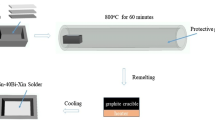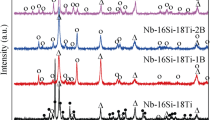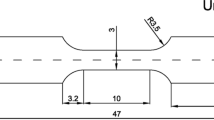Abstract
In this study, the thermal properties, mechanical properties, and microstructure evolution of Sn-xBi (x = 0, 10, 17, 20, 30, 40, 50, and 58 wt.%, respectively) alloys were investigated via differential scanning calorimetry, scanning electron microscope during and after tensile test. The results reveal that the shapes of precipitated Bi particles relate to the cooling rate, that is, sphere in water cooling condition and short rod like cooled in air. Beta tin phase strengthened by Bi particle precipitation offers superior performance than Sn-Bi eutectic structure. The result also clearly demonstrates the deformation and fracture modes of Sn-Bi alloys with different microstructure through in situ observations during tensile loading. The deformation of Sn-17Bi alloy deforms based on the grain boundary diffusion. For Sn-58Bi alloy, the deformation is mainly resulted by grain boundary sliding during even deformation stage and the phase sliding between Bi-rich and Sn-rich phase boundary after necking. And the latter accounts for the majority. Sn-50Bi alloy deforms through grain boundary sliding of eutectic phase and phase boundary sliding between beta tin phase strengthen by precipitated Bi and eutectic phase. Moreover, Sn-rich phase works as floating grains, does not participate in the deformation, but provides sliding interface with the eutectic part, which promotes the continuous plastic deformation.
Graphical abstract
Sn-50Bi alloy deforms through slip between grain boundaries within eutectic region and phase boundary sliding between beta tin phase and eutectic phase.













Similar content being viewed by others
Data availability
The data used to support the findings of this study are available from the corresponding author upon request.
References
Cheng S, Huang C, Pecht M (2017) A review of lead-free solders for electronics applications. Microelectron Reliab 75:77–95
Gao N et al (2017) The effect of the material and size of the flip-chip plastic package on warping, in 18th International Conference on Electronic Packaging Technology (ICEPT) p. 352–356
Hu M, Kresge L, Lee N(2013) Low-cost high-reliability assembly of thermally warped PoP with novel epoxy flux on solder paste, in 14th International Conference on Electronic Packaging Technology(ICEPT). p. 173–181
Powers TA, Singler TJ, Clum JA (1994) Role of tin content in the wetting of Cu and Au by tin-bismuth solders. J Electron Mater 23:773–778
Morgana Ribas,Anil Kumar, Divya Kosuri, Raghu R. Rangaraju, Pritha Choudhury,Suresh Telu, Siuli Sarkar(2017) Low temperature soldering using Sn-Bi alloys, in Proceedings of SMTA International. Rosemont. IL, USA
Morgana Ribas, Tom Hunsinger, Traian Cucu, Ramakrishna H V, Garian Lim, Mike Murphy(2018) (The printed circuit assembler’s guide to...™ -) Low-temperature soldering,BR Publishing, Inc. eBook ISBN:978-0-9998648-4-5
Hu FQ et al (2018) Influences of Ag addition to Sn-58Bi solder on SnBi/Cu interfacial reaction. Mater Lett 214:142–145
Li Y et al (2016) Improving the mechanical performance of Sn57.6Bi0.4Ag solder joints on Au/Ni/Cu pads during aging and electromigration through the addition of tungsten (W) nanoparticle reinforcement. Mater Sci Eng: A 669:291–303
Wu X et al (2017) Microstructure and mechanical behavior of Sn-40Bi-xCu alloy. J Mater Sci: Mater Electron 28(20):15708–15717
Zhang H, Sun F, Liu Y (2019) Thermal and mechanical properties of micro Cu doped Sn58Bi solder paste for attaching LED lamps. J Mater Sci: Mater Electron 30(1):340–347
Kanlayasiri K, Kongchayasukawat RH (2018) Property alterations of Sn-0.6Cu-0.05Ni-Ge lead-free solder by Ag, Bi, In and Sb addition. Trans Nonferrous Met Soc China 28(6):1166–1175
Zhu W et al (2019) Improved microstructure and mechanical properties for SnBi solder alloy by addition of Cr powders. J Alloy Compd 789:805–813
Nan C et al (2017) Measurement and modeling of phase equilibria for Sb-Sn and Bi-Sb-Sn alloys in vacuum distillation. Fluid Phase Equilib 442:62–67
Zhang C et al (2014) Effect of Sb content on properties of Sn-Bi solders. Trans Nonferrous Met Soc China 24(1):184–191
Ma D, Wu P (2016) Improved microstructure and mechanical properties for Sn58Bi0.7Zn solder joint by addition of graphene nanosheets. J Alloys Compd 671:127–136
Zhu QS et al (2009) Effect of Zn addition on microstructure of Sn-Bi joint, in 2009 International Conference on Electronic Packaging Technology & High Density Packaging (ICEPT). Beijing, China, p. 1043–1046
Wang XJ et al (2014) Effect of doping Al on the liquid oxidation of Sn-Bi-Zn solder. J Mater Sci: Mater Electron 24:2297–2304
Chen X et al (2015) Effect of In on microstructure, thermodynamic characteristic and mechanical properties of Sn–Bi based lead-free solder. J Alloy Compd 633:377–383
Kim SH et al (2017) Thermo-mechanical evolution of ternary Bi–Sn–In solder micropowders and nanoparticles reflowed on a flexible PET substrate. Appl Surf Sci 415:28–34
Li Q et al (2016) Characterization of low-melting-point Sn-Bi-In lead-free solders. J Electron Mater 45(11):5800–5810
Wu X et al (2020) Effect of In addition on microstructure and mechanical properties of Sn–40Bi alloys. J Mater Sci 55(7):3092–3106
Zhao J et al (2004) Influence of Bi on microstructures evolution and mechanical properties in Sn–Ag–Cu lead-free solder. J Alloy Compd 375(1):196–201
Zhang XP et al (2007) Creep and fatigue behaviors of the lead-free Sn–Ag–Cu–Bi and Sn60Pb40 solder interconnections at elevated temperatures. J Mater Sci: Mater Electron 18(6):665–670
Olofinjana A et al (2019) Studies of the solidification characteristics in Sn-Ag-Cu-Bi solder alloys. Procedia Manuf 30:596–603
Zhao G, Wen G, Sheng G (2017) Influence of rapid solidification on Sn–8Zn–3Bi alloy characteristics and microstructural evolution of solder/Cu joints during elevated temperature aging. Trans Nonferrous Met Soc China 27(1):234–240
El-Daly AA, Ibrahiem AA (2018) The role of delayed elasticity and stress relaxation in Sn-Bi-Cu lead-free solders solidified under permanent magnet stirring. J Alloy Compd 740:801–809
Lai Z, Ye D (2016) Microstructure and properties of Sn-10Bi-xCu solder alloy/joint. J Electron Mater 45(7):3702–3711
Silva BL, Garcia A, Spinelli JE (2017) Complex eutectic growth and Bi precipitation in ternary Sn-Bi-Cu and Sn-Bi-Ag alloys. J Alloy Compd 691:600–605
Takao H, Yamada A, Hasegawa H (2004) Mechanical properties and solder Joint reliability of low-melting Sn-Bi-Cu lead free solder alloy. R&D Rev Toyota CRDL 39(2):41
Peng C et al (2011) Influence of minor Ag nano-particles additions on the microstructure of Sn30Bi0.5Cu solder reacted with a Cu substrate. J Mater Sci: Mater Electron 22(7):797–806
Zhang L, Sun L, Guo Y (2015) Microstructures and properties of Sn58Bi, Sn35Bi0.3Ag, Sn35Bi1.0Ag solder and solder joints. J Mater Sci: Mater Electron 26(10):7629–7634
Zang L et al (2012) Spreading process and interfacial characteristic of Sn-17Bi-0.5Cu/Ni at temperatures ranging from 523K to 673K. Colloids Surf A: Physicochem Eng Asp 414:57–65
Zhou H et al (2021) Effect of Laser Power on Microstructure and Micro-Galvanic Corrosion Behavior of a 6061-T6 Aluminum Alloy Welding Joints. Metals 11(31)
Abd El-Salam F et al (2009) Thermally induced variations in structural and mechanical properties of rapid solidified Tin-based alloys. Mater Sci Eng, A 506(1–2):135–140
Zhang QK et al (2017) Viscoplastic creep and microstructure evolution of Sn-based lead-free solders at low strain. Mater Sci Eng, A 701:187–195
Qiao YX, Corrosion YPC (2021) Behavior of a Nickel-free high-nitrogen stainless steel with hydrogen charging. JOM https://doi.org/10.1007/s11837-021-04569-2
Kerr M, Chawla N (2004) Creep deformation behaviour of Sn-3.5Ag solder at small length scales. JOM 56(6):50–54
Kerr M, Chawla N (2004) Creep deformation behavior of Sn–3.5Ag solder/Cu couple at small length scales. Acta Mater 52(15):4527–4535
Okkerse B (1954) Self-diffusion in lead. Acta Metall 2:551–553
Ding Y et al (2006) In situ TEM observation of microcrack nucleation and propagation in pure tin solder. Mater Sci Eng, B 127(1):62–69
Qiao Y et al (2021) Effect of hydrogen charging on microstructural evolution and corrosion behavior of Ti-4Al-2V-1Mo-1Fe alloy. J Mater Sci Technol 60:168–176
Han J, Guo F (2019) Double tricrystal nucleation behavior in Pb-free BGA solder joints. Microelectron Reliab 98:1–9
Funding
This study was funded by Yunnan Science and Technology Major Project (grant number 2019ZE001) and the Research and Development Funding of Yunnan Tin Group (Holding) Co, Ltd.
Author information
Authors and Affiliations
Corresponding authors
Ethics declarations
Conflict of interest
The authors declare that they have no conflict of interest.
Additional information
Publisher’s Note
Springer Nature remains neutral with regard to jurisdictional claims in published maps and institutional affiliations.
Rights and permissions
About this article
Cite this article
Cai, S., Luo, X., Peng, J. et al. Deformation mechanism of various Sn-xBi alloys under tensile tests. Adv Compos Hybrid Mater 4, 379–391 (2021). https://doi.org/10.1007/s42114-021-00231-2
Received:
Revised:
Accepted:
Published:
Issue Date:
DOI: https://doi.org/10.1007/s42114-021-00231-2




